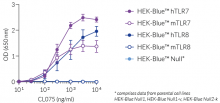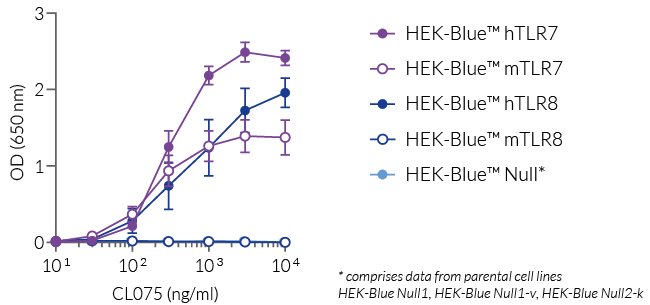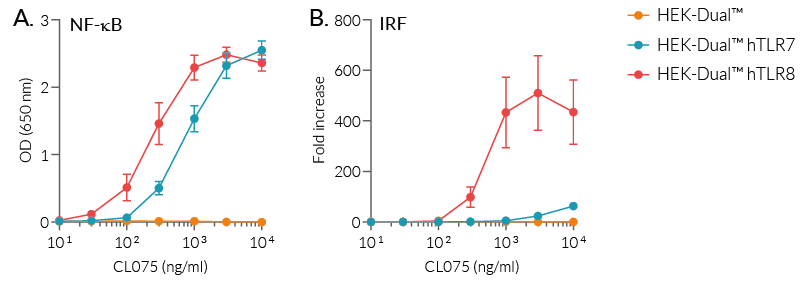CL075 (3M002)
| Product | Unit size | Cat. code | Docs. | Qty. | Price | |
|---|---|---|---|---|---|---|
|
CL075 Thiazoloquinoline compound |
Show product |
500 µg 5 mg |
tlrl-c75
|
|
TLR7/8 Agonist - Thiazoquinoline compound

TLR7/TLR8 activation with CL075
 InvivoGen also offers:
InvivoGen also offers:
• TLR reporter cells: HEK293, RAW, THP-1 cells
• TLR research tools: Antibodies, Inhibitors, etc.
CL075 (3M002) is a thiazoquinoline derivative that, like the base analog R848 (Resiquimod), induces differential Toll-like receptor 7 (TLR7) and/or TLR8 responses in human and murine immune cells. TLR7 and TLR8 are endosomal pattern recognition receptors that play an important role in the antiviral immune response [1].
Mode of action
CL075 was originally described as a human TLR8 (hTLR8) agonist because it triggers a potent NF-κB activation in hTLR8 reporter cells when compared to hTLR7 reporter cells [2].
In human peripheral blood mononuclear cells (PBMCs), CL075 induces the production of TNF-α and IL-12, and to a lesser extent IFN-α. This cytokine profile is similar to the one induced by the hTLR8 agonist ssRNA40 [2]. CL075 also induces the NF-κB-dependent production of pro-inflammatory cytokines [2]. CL075 efficiently stimulates cytokine production from monocytes and myeloid dendritic cells (DCs) among human PBMCs [2]. This compound has been used to optimize the ex vivo maturation of monocyte-derived DCs for developing DC-based anti-pathogen or anti-tumor vaccines [3].
Using InvivoGen's HEK-Blue™ reporter cell lines expressing human or mouse TLR7 or TLR8, we established that CL075 is a TLR7/8 agonist. It activates human and murine TLR7 (h/mTLR7), hTLR8, but not mTLR8. Moreover, CL075 is able to activate TLR7- and TLR8-dependent NF-κB and IRF pathways, as assessed using our HEK-Dual™ reporter cell lines expressing two reporter genes for the NF-κB-inducible SEAP and IRF-inducible Lucia luciferase, as well as human TLR7 or TLR8. Interestingly, CL075 is more potent in activating the hTLR8-dependent IRF pathway than for hTLR7 (see figure).
Key features of CL075
- Agonist of hTLR7 and hTLR8 with higher potency towards hTLR8 in the IRF pathway
- Agonist of mTLR7, but not mTLR8
- Each lot of CL075 is highly pure (≥95%) and functionally tested
![]() Read our review about TLR7 and TLR8.
Read our review about TLR7 and TLR8.
References:
1. Georg P. & Sander L.E., 2019. Innate sensors that regulate vaccine responses. Curr. Op. Immunol. 59:31.
2. Gorden K.B. et al., 2005. Synthetic TLR agonists reveal functional differences between human TLR7 and TLR8. J. Immunol. 174(3):1259-68.
3. Spranger S. et al., 2010. Generation of Th1-polarizing dendritic cells using the TLR7/8 agonist CL075. J. Immunol. 185:738-747.
Specifications
Specificity: human TLR7/8 and mouse TLR7 agonist
CAS number: 256922-53-9
Formula: C13H13N3S
Molecular weight: 243.33 g/mol
Solubility: 1 mg/ml in water
Working Concentration:
- 0.1 - 5 μg/ml CL075 for human TLR8 and mouse TLR7 in cell culture assays
- 0.5 - 5 μg/ml CL075 for human TLR7 in cell culture assays
Quality control:
- Purity: ≥95% (UHPLC)
- The biological activity of CL075 has been verified using HEK-Blue™ hTLR7 cells, HEK-Blue™ hTLR8 cells, and HEK-Blue™ mTLR7 cells.
- The absence of bacterial contamination has been confirmed using HEK-Blue™ hTLR2 cells (for lipoproteins) and HEK-Blue™ hTLR4 cells (for endotoxins).
Contents
CL075 is available in two quantities:
tlrl-c75:
- 500 µg CL075
- 1.5 ml of endotoxin-free water
tlrl-c75-5:
- 5 mg CL075
- 10 ml of endotoxin-free water
![]() CL075 is provided as a lyophilized powder and shipped at room temperature.
CL075 is provided as a lyophilized powder and shipped at room temperature.
![]() Upon receipt, store at -20°C.
Upon receipt, store at -20°C.
Back to the top
Details
TLR7 and TLR8:
TLR7 and TLR8 are endosomal pattern recognition receptors that share structural homology [1]. Both receptors are activated by single-stranded RNA (ssRNA) molecules, however, they exhibit different ligand-binding specificities and cellular expression patterns suggesting that they have nonredundant specialized roles.
TLR7 is essentially expressed by plasmacytoid dendritic cells (pDCs) but is also found in B cells and other myeloid cells [2] while TLR8 is highly expressed by myeloid cells and is absent from pDCs and B cells [2].
The endosomal distribution of TLR7 and TLR8 allows them to scan for the presence of microbial RNA in the phagocytic cargo. Their activation leads to NF-κB-, AP1-, and interferon regulatory factor (IRF)-mediated production of type I interferons (IFN-α/β) and pro-inflammatory cytokines [2].
Structural analyses have revealed that both TLR7 and TLR8 possess two binding sites (designated as Site 1 and Site 2) which do not share the same specificities.
Site 1 is highly conserved between TLR7 and TLR8 and binds nucleosides (guanosine (G) for TLR7 and uridine (U) for TLR8) or base analogs. The ligand preference for TLR7 and TLR8 is thus explained by the presence of specific residues in Site 1. Site 1 occupancy allows receptor dimerization and signaling.
Site 2 is less conserved and binds ssRNA with U(U) and U(G) motifs, respectively [3, 4]. Of note, ssRNA-binding to Site 2 is not sufficient for the formation of a signaling-competent TLR dimer but it strongly enhances the binding affinity of Site 1 [3, 4]. Thus, TLR7 and TLR8 appear to sense distinct RNA-degradation products rather than full-length ssRNAs [4].
1. Chuang T.H. & Ulevitch R.J., 2000. Cloning and characterization of a sub-family of human toll-like receptors: hTLR7, hTLR8, and hTLR9. Eur Cytokine Netw, 11:372-8.
2. Georg P. & Sander L.E., 2019. Innate sensors that regulate vaccine responses. Curr. Op. Immunol. 59:31.
3. Zhang Z. et al., 2018. Structural analyses of Toll-like receptor 7 reveal detailed RNA sequence specificity and recognition mechanism of agonistic ligands. Cell Rep. 25:3371.
4. Tanji H. et al., 2015. Toll-like receptor 8 senses degradation products of single-stranded RNA. Nat. Struct. Mol. Biol. 22:109.
Chemical structure of CL075:









